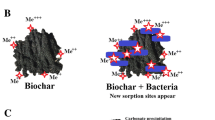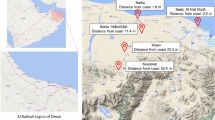Abstract
Urbanozems (Urbic Technosols) contaminated by heavy metals and polychlorbiphenyls (Urbic Technosols Toxic) and intruzems (Urbic Technosols Toxic) were studied in Moscow; additionally, we studied recreazems (Urbic Technosols Thaptohumic) and culturozems (Urbic Technosols Pantohumic) on the territory of the Botanical Garden of Moscow State University (Aptekarskii Ogorod, the Apothecaries’ Garden). In the soils contaminated with heavy metals and oil products, the number of viable cells of bacteria decreased, whereas the content of filterable forms of bacteria increased. The taxonomic structure of saprotrophic bacterial complexes in contaminated urban soils was transformed towards an increase in the diversity of bacterial taxa atypical of natural undisturbed soils. Rhodococci (Rhodococcus genus) predominated in the soils contaminated with oil and polychlorbiphenyls, enterobacteria (Escherichia, Enterobacter, and Klebsiella genera) predominated in the soils contaminated with municipal wastes, and Arthrobacter genus was dominant in the soils contaminated with cement dust. Soils of both Botanical Gardens of Moscow State University were characterized by the high population density and specific distribution of bacteria in the profile; the structure of their saprotrophic bacterial complex had some similarity with that in the soils of more southern regions. The obtained data on the bacterial diversity of urban soils attest to considerable transformation of bacterial communities both in the contaminated urban soils and in the soils of botanical gardens.
Similar content being viewed by others
References
N. D. Ananyeva and D. I. Nikitin, “Size of bacteria in some soil types,” Pochvovedenie, No. 4, 132–135 (1979).
T. G. Dobrovol’skaya, The Structure of Bacterial Communities in Soils (Akademkniga, Moscow, 2002) [in Russian].
T. G. Dobrovol’skaya, D. G. Zvyagintsev, I. Yu. Chernov, A. V. Golovchenko, G. M. Zenova, L. V. Lysak, N. A. Manucharova, O. E. Marfenina, L. M. Polyanskaya, A. L. Stepanov, and M. M. Umarov, “The role of microorganisms in the ecological functions of soils,” Eurasian Soil Sci. 48 (9), 959–967 (2015).
V. I. Duda, N. E. Suzina, V. N. Polivtseva, and A. M. Boronin, “Ultramicrobacteria: formation of the concept and contribution of ultramicrobacteria to biology,” Microbiology (Moscow) 81, 379–390 (2012).
D. G. Zvyagintsev, Soil and Microorganisms (Moscow State Univ., Moscow, 1987) [in Russian].
N. A. Krasil’nikov, “Noncellular forms of microorganisms,” Usp. Sovrem. Biol. 54 (6), 22–32 (1954).
L. V. Lysak, T. G. Dobrovol’skaya, and I. N. Skvortsova, Evaluation of Bacterial Diversity of Soils and Identification of Soil Bacteria (MAKS-Press, Moscow, 2003) [in Russian].
L. V. Lysak, E. V. Lapygina, I. A. Konova, and D. G. Zvyagintsev, “Definition of the physiological condition of bacteria in soil by means of luminescent dye L7012,” Biol. Bull. (Moscow) 36, 639–642 (2009).
L. V. Lysak, E. V. Lapygina, I. A. Konova, and D. G. Zvyagintsev, “Population density and taxonomic composition of bacterial nanoforms in soils of Russia,” Eurasian Soil Sci. 43 765–770 (2010).
L. V. Lysak and N. N. Sidorenko, “Species diversity of rhodococci in urban soils,” Microbiology (Moscow) 66, 480–481 (1997).
L. V. Lysak and N. N. Sidorenko, “Specific microbial communities of polluted soils,” The III Congress of Dokuchaev Society of Soil Scientists, Abstracts of Papers (Moscow, 2000), Book 2, pp. 57–59.
L. V. Lysak, N. N. Sidorenko, O. E. Marfenina, and D. G. Zvyagintsev, “Microbial complexes in urban soils,” Eurasian Soil Sci. 33 (1), 70–75 (2000).
Practical Manual on Soil Microbiology and Biochemistry, Ed. by D. G. Zvyagintsev (Moscow State Univ., Moscow, 1991) [in Russian].
D. A. Nikitin, O. E. Marfenina, A. G. Kudinova, L. V. Lysak, N. S. Mergelov, A. V. Dolgikh, and A. V. Lupachev, “Microbial biomass and biological activity of soils and soil-like bodies in coastal oases of Antarctica,” Eurasian Soil Sci. 50 (9), 1086–1097 (2017).
Soil, City, and Ecology, Ed. by G. V. Dobrovol’skii (Za Ekonomicheskuyu Gramotnost’, Moscow, 1997) [in Russian].
A. V. Rappoport, L. V. Lysak, T. V. Prokof’eva, and M. N. Stroganova, “Specific soils of the Botanical Garden of Moscow State University,” Vestn. Mosk. Univ., Ser. 17: Pochvoved., No. 3, 26–32 (2001).
M. S. Rozanova, T. V. Prokof’eva, L. V. Lysak, and A. A. Rakhleeva, “Soil organic matter in the Moscow State University botanical garden on the Vorob’evy Hills,” Eurasian Soil Sci. 49 (9), 1013–1025 (2016).
I. N. Skvortsova, A. V. Rappoport, T. V. Prokof’eva, and A. E. Andreeva, “Biological properties of soils in the Moscow State University Botanical Garden: The branch on Prospekt Mira,” Eurasian Soil Sci. 39 (7), 771–778 (2006).
V. S. Soina, L. V. Lysak, I. A. Konova, E. V. Lapygina, and D. G. Zvyagintsev, “Study of ultramicrobacteria (nanoforms) in soils and subsoil deposits by electron microscopy,” Eurasian Soil Sci. 45 (11), 1048–1056 (2012).
Ecological Functions of Urban Soils, Ed. by A. S. Kurbatova (Madzhenta, Moscow, 2004) [in Russian].
P. E. Axelrood, M. L. Chow, C. S. Arnold, K. Lu, J. M. McDermott, and J. Davies, “Cultivation-dependent characterization of bacterial diversity from British Columbia forest soils subjected to disturbance,” Can. J. Microbiol. 48 (7), 643–654 (2002).
B. Braun, U. Bockelmann, E. Grohmann, and U. Szewzyk, “Polyphasic characterization of the bacterial community in an urban soil profile with in situ and culture-dependent methods,” Appl. Soil Ecol. 31 (3), 267–279 (2006).
O. Dilly, J. Bloem, A. Vos, and J. C. Munch, “Bacterial diversity in agricultural soils during litter decomposition,” Appl. Environ. Microbiol. 70 (1), 468–474 (2004).
M. C. Horner-Devine, K. M. Carney, and J. M. Bohannan, “An ecological perspective on bacterial biodiversity,” Proc. R. Soc. B 271, 113–122 (2004).
P. Nannipieri, J. Ascher, M. T. Ceccherini, L. Landi, G. Pietramellara, and G. Renella, “Microbial diversity and soil functions,” Eur. J. Soil Sci. 54, 655–670 (2003).
N. Panikov, “Contribution of nanosized bacteria to the total biomass and activity of a soil microbial community,” Adv. Appl. Microbiol. 57, 245–296 (2005).
V. S. Soina, A. L. Mulyukin, E. V. Demkina, E. A. Vorobyova, and G. I. El-Registan, “The structure of resting bacterial population in soil permafrost,” Astrobiology 4, 435–458 (2004).
S. Tarleral, K. Jangid, A. H. Ivester, W. B. Whitman, and M. A. Williams, “Microbial community succession and bacterial diversity in soils during 77000 years of ecosystem development,” FEMS Microbiol. Ecol. 64 (1), 129–140 (2008).
A. Winding, K. Hund-Rinke, and M. Rutgers, “The use microorganisms in ecological soil classification and assessment concepts,” Ecotoxicol. Environ. Saf. 62 (2), 230–248 (2005).
Author information
Authors and Affiliations
Corresponding author
Additional information
Original Russian Text © L.V. Lysak, E.V. Lapygina, 2018, published in Pochvovedenie, 2018, No. 9, pp. 1108–1114.
Proceedings of the 9th International Congress Soils of Urban, Industrial, Traffic, Mining, and Military Areas (SUITMA).
Rights and permissions
About this article
Cite this article
Lysak, L.V., Lapygina, E.V. The Diversity of Bacterial Communities in Urban Soils. Eurasian Soil Sc. 51, 1050–1056 (2018). https://doi.org/10.1134/S1064229318090077
Received:
Published:
Issue Date:
DOI: https://doi.org/10.1134/S1064229318090077




